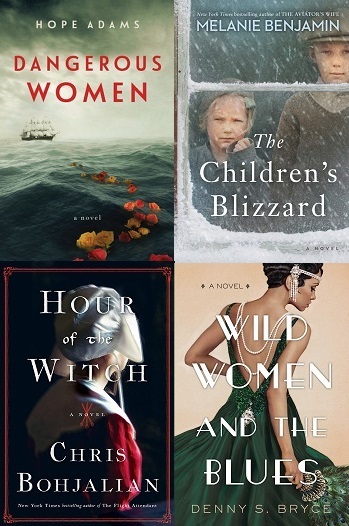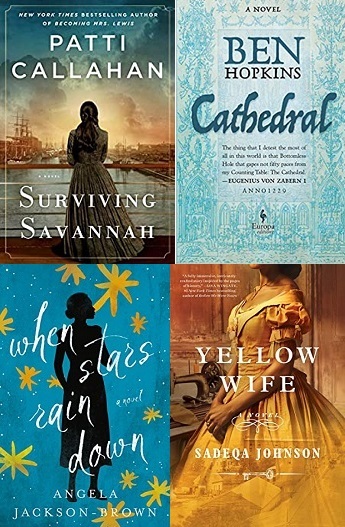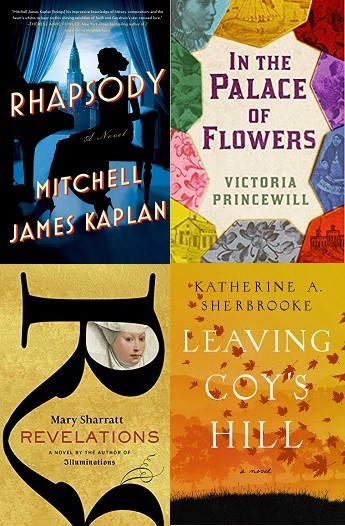Here's the first in a series of previews of upcoming 2021 releases. As you've no doubt noticed, publishers' interest in World War II as a historical fiction setting continues unabated. I've been keeping an eye on current publishing deals, and the trend looks to last through 2022 at least. For readers who prefer earlier settings, or who enjoy focusing on a wide variety of eras, this post is for you. These dozen titles will be appearing from US publishers in the first half of next year. Links go to the books' Goodreads pages.

Hope Adams' first novel Dangerous Women (Berkley, Feb.) follows 180 Englishwomen on a convict ship to Van Diemen's Land (modern Tasmania) in 1841. Along the way, they assemble a giant quilt, an artifact that can be viewed today, and evade a potential murderer on board. The setting for Melanie Benjamin's The Children's Blizzard (Delacorte, Feb.) is the Dakota Territory in January 1888. Young people and their teachers were in school as a sudden blizzard hit, leaving them with tough decisions to make. Moving to an earlier period than his usual, Chris Bohjalian's Hour of the Witch (Doubleday, Apr.) delves into the life of a young Puritan woman in 1660s Boston who's desperate to end her violent marriage. And for her debut, Wild Women and the Blues (Kensington, Mar.), Denny S. Bryce intertwines the stories of a chorus girl in Jazz Age-Chicago and a modern film student who interviews her decades later, when she's 110 years old.

Incorporating another pulled-from-history subject, Patti Callahan (
Becoming Mrs. Lewis) focuses on the sinking of the steamship
Pulaski in 1838, a family affected by the tragedy, and a contemporary professor researching the topic, in her
Surviving Savannah
(Berkley, Mar). Ben Hopkins'
Cathedral
(Europa, Jan.) looks tailor-made for Ken Follett fans, with its subject the bustling community surrounding the construction of a Gothic cathedral in 13th-century Germany.
When Stars Rain Down
by Angela Jackson-Brown (Thomas Nelson, Apr.) takes us to small-town, Depression-era Georgia with the story of a young Black woman coming of age during a time when the KKK is wreaking havoc in her community. Sadeqa Johnson's
Yellow Wife (Simon & Schuster, Jan.),
set in the mid-19th century, recounts the tale of a young woman hoping to be granted her freedom but who finds herself returned to slavery and working in a notorious Virginia jail (based on a true story).

Mitchell James Kaplan's third novel, Rhapsody (Gallery, Mar.) centers on the decade-long affair between composers George Gershwin and Kay Swift in the 1920s-30s. In the Palace of Flowers by Victoria Princewill (Cassava Republic, Feb.) takes place in the royal court of Iran in the 1890s, with two enslaved people as its protagonists. (The UK release date was this August.) Mary Sharratt's historical novels are always excellent, and I'm looking forward to Revelations (HMH, Apr.), her take on English mystics Julian of Norwich and Margery Kempe in the 15th century. Lastly, Leaving Coy's Hill by Katherine A. Sherbrooke (Pegasus, May) is another work of biographical fiction, illuminating the life of Lucy Stone, a 19th-century American orator and abolitionist.
 newest »
newest »
 newest »
newest »
 Some historical novels about WWII are favorites of mine, but I've been feeling overwhelmed by them for the last few years. So it is wonderful to find a list that focuses on other centuries, especially the 19th century in continental Europe or the United States. Just what my reading list needed!
Some historical novels about WWII are favorites of mine, but I've been feeling overwhelmed by them for the last few years. So it is wonderful to find a list that focuses on other centuries, especially the 19th century in continental Europe or the United States. Just what my reading list needed!







